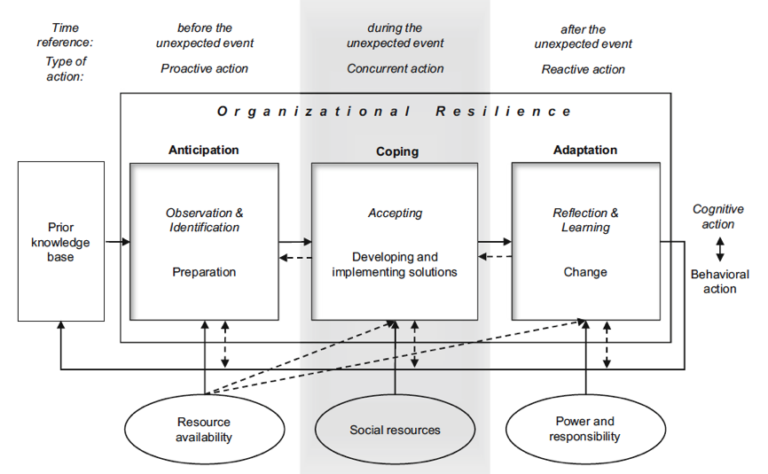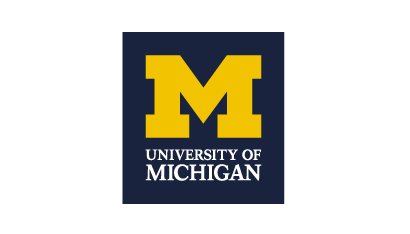The Anticipation Stage in the Organizational Resilience model
The first stage of Dr. Duchek’s Organizational Resilience model is that of Anticipation. In this reading, you will examine the characteristics of and processes within this first stage. To help frame the exploration, a couple of questions will be used. First: Why is early warning and prevention critical to organizational resilience? Second: How can we leverage our understanding of and relationships with stakeholders to identify potential issues that could eventually become crisis-level events? As you explore this first modular stage, keep these questions in mind.

Anticipation capabilities
In her article, Dr. Duchek summarizes the characteristics of the Anticipation stage like this:
Anticipation is the first dimension of organizational resilience and describes its preventive aspects relative to a disturbance. It refers to the ability to detect critical developments within the firm or in its environment and to adapt proactively. This does not mean that resilient organizations can prevent every failure or crisis. Crises often do not announce their arrival. However, some firms are able to see the unexpected faster than others, and they are able to immediately react to it while others ‘‘wait and see’’. (Some researchers) indicate that systems need anticipation capabilities to avoid threatening situations or at least minimize potential negative consequences. They define anticipation as ‘‘the ability to ‘look down the line’ to determine how the environment is expected to change with a view to making decisions and taking actions in the present that promote desirable outcomes and circumvent disruptions in the future’’. Based on prior studies, we assume that the anticipation stage comprises three specific capabilities: the ability to observe internal and external developments, the ability to identify critical developments and potential threats, and—as far as possible—to prepare for unexpected events.
Let’s spend a few minutes on each of these three specific capabilities to better understand why each are important and how high stakes leaders can deploy and develop them to increase organizational resilience.
Observing Developments and Identifying Threats
In the Duchek article, many references are shared regarding different ways to think about conducting internal and external observations for the purposes of identifying potential threats to the enterprise. For some detailed descriptions and sources of these different perspectives, feel free to refer to the original article. Here, in this activity, let’s accept that researchers have identified many ways that observations can be conducted, documented, tracked, and analyzed. This will allow us to focus on two specific aspects of observation that are most useful for high stakes leaders – and both are related to relationships with stakeholders. We’ll refer to these two considerations as: 1) Establishing the optimum culture for internal stakeholders and their focus on internal observations, and 2) Establishing exceptional relationships with external stakeholders for external observations.
Internal Observations. Which of our primary stakeholder groups is in the best position to conduct internal observations for indications of possible trouble for an organization? Of course, the employee group. If your goal as a high stakes leader was to create the ideal environment for motivating employees to be on the lookout for developments that require attention, what would you do? While this is not a course on organization culture, there are some lessons from culture experts that we can apply to this question.
First, if you want your employees to serve in an observational capacity, in other words, if you want them to be on the lookout for areas of opportunity for improvement, then you need to make sure they understand that this is what you expect them to do. To increase an organization’s resilience, this is exactly what you will want to do. You want and need your employees to serve as observers for improvement opportunities. When you share this expectation, you will receive lots of questions about what they should be looking for, how they should report what they find, what happens when they do report something, will their identity be shared or will observations be anonymous? These are all great questions. We won’t discuss these here, but we will acknowledge that if you want your employees to support the organization in this way, then you need to tell them of your expectations.
Second, you will need to tell your employees what to look for. At organizations that do this most effectively, employees are educated on the sorts of threats they are likely to see and how they are expected to deal with or report them when necessary. Earlier in this course, you read about a collection of crises that took place at United Airlines, Samsung, Starbucks, and Boeing. As you think about any of these crises, do you suppose that employees of those companies had observed indications that a significant problem might arise if something wasn’t done to address the issue(s)? The answer is probably a resounding yes. It is rare that in internally generated crisis doesn’t offer early warning signals – signals that employees are likely to see. Therefore, to improve resilience and the capacity for identifying organizational threats that may start small and grow rapidly, employees should be taught what to look for and how to share their observations when they see something of note. Third, with employee expectations set and a sense of clarity around the types of things that are targets for observation and subsequent reporting, the organization needs a mechanism for passing the information from an observer to someone or some team that can address the issue(s). The term mechanism is used here in a very broad sense. It will include processes for dealing with all of the questions mentioned earlier — questions about reporting processes, communication channels, anonymity, consequences, reputational safety, and the like. These will all take time and effort to define and communicate, but done effectively and with a genuine commitment to employee engagement in the identification of organizational threats and opportunities for improvement, a culture can be created that wonderfully supports a capacity for resilience.
External Observations. Relationships with external stakeholders are quite a bit different than relationships with internal stakeholders. This is not breaking news. All of the steps shared in the previous section are made possible by the unique nature and value proposition of the employer-employee relationship. So how does an organization engage external stakeholders to serve as observers for potential threats to the enterprise? It does so exactly as we have already learned in this course – by taking the time to understand the interests of each and building relationships with them.
Consider how your organization gets feedback on its products and services from customers. How does it learn about what customers are buying; what they like best about your offerings; what they like least; and what they would change if they could? These are the types of questions being asked today of customers in just about every sector. Customer feedback has become a primary source for product development and innovation. Shouldn’t this well-established feedback loop with customers include an opportunity to collect information on threats to the organization? Of course, it should!
Customers have demonstrated a willingness to share their thoughts and feedback in any number of forums. They will respond to surveys, post comments on websites, and many are happy to participate in focus groups or on discussion panels. As a high stakes leader, your threat detection efforts might benefit considerably by leveraging these connections to not only get feedback on product features and future innovations, but also on customer concerns and minor incidents involving your products. Second only to your employees in their willingness to help your company succeed, customers can be an exceptional resource in your threat identification efforts.
Can your other external stakeholders also support your external observation and threat detection efforts? They certainly can. As with your customers, strong relationships can create opportunities to both formally and informally solicit observations and receive feedback that can be useful to your organization. While we won’t explore this concept further here, consider what you could be doing with your external stakeholders to more effectively engage them to help you learn as much as you can about opportunities to make your company better and ways to more effectively identify potential issues that could grow into full blown crises.
Preparing for Unexpected Events
Here, it’s worth briefly considering why resilience requires some dedicated effort in this regard, to be as prepared as possible for the inevitable crisis that lies ahead.
According to Dr. Duchek’s research,
“Being prepared means that a firm or agency is equipped to deal with unforeseen adversity and it is ready to capitalize on unexpected opportunities.” This means that preparation capabilities help to develop resources that are necessary in times of crisis (e.g., suitable recovery plans, effective relationships, and mutual understanding). Important insights into this part of resilience can be gained from risk management, emergency planning, and business continuity management (BCM). Especially BCM — as a recent evolution of risk-based practice — provides important insights into how organizations can prepare for critical events; for example, how organizations can develop suitable recovery plans for previously identified critical business operations. Training and simulation practices can ensure that the benefits and objectives of such plans are achieved. However, it is not solely the developed plans and formal procedures that prepare organizations for the great variety of unexpected events. Such events often do not correspond with planning assumptions and require intuitive acting and ad hoc decisions. “The most important benefit of preparing the plan is the growing of effective relationships and mutual understanding among those involved in the plan preparation process.” Thus, preparation does not mean planning for the unexpected—this is impossible. Rather, it means that organizations prepare without knowing if, when, or where an unexpected event will occur in the future.
It should be clear that two very important processes take place in the Anticipation stage of the resilience model presented in this activity. The first is that observations and threat detection efforts can increase organizational resilience by helping organizations identify and address potentially threatening issues before they can reach crisis-level. The second is that organizations must create mechanisms to deal with crises when they do appear, as threat detection efforts will not create an impenetrable barrier against them.
What can you and your organization do to improve the effectiveness of your Anticipation efforts?
Share this
High Stakes Leadership: Leading in Times of Crisis

High Stakes Leadership: Leading in Times of Crisis


Reach your personal and professional goals
Unlock access to hundreds of expert online courses and degrees from top universities and educators to gain accredited qualifications and professional CV-building certificates.
Join over 18 million learners to launch, switch or build upon your career, all at your own pace, across a wide range of topic areas.
Register to receive updates
-
Create an account to receive our newsletter, course recommendations and promotions.
Register for free







